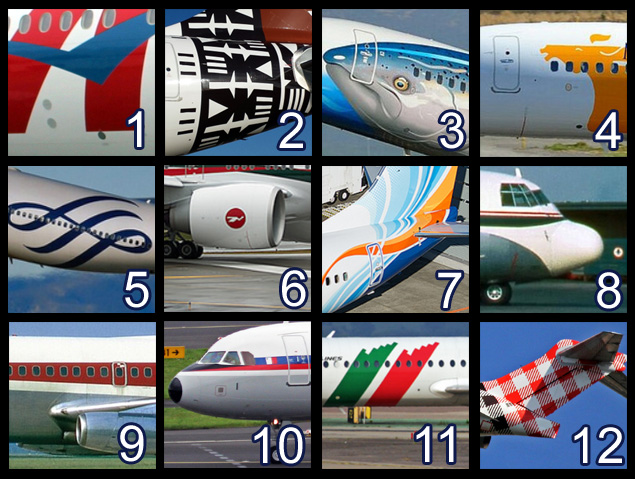
How well do you know your airline liveries?
I think this challenge was a nice mixture of easy and hard liveries/airliners. Some of you were amazing and got all 12. Many of you were very close. Others took a nice stab at guessing. Without further adieu — here are the answers:
#1: TAM Airlines Boeing 777-300ER by David Parker Brown
#2: Fiji Airways Airbus A330-300 by Jason Rabinowitz
#3: Alaska Airlines Salmon-Thirty-Salmon livery on a Boeing 737-800 by Bob Garrard
#4 Mongolian Airlines Boeing 737-800 by Bob Garrard
#5 China Airlines Sky Team livery on a Boeing 747-400 by Bob Garrard
#6 Biman Bangladesh Airlines Boeing 777-300ER by Bernie Leighton
#7 Fly Dubai Boeing 737-800 by Bernie Leighton
#8 Delta Air Lines Air Freighter Lockheed L100 Herecules by Bob Garrard
#9 TWA Convair 880 by Bob Garrard
#10 Air Malta retro jet livery on an Airbus A320 by Ken Fielding
#11 PGA Portugalia Airlines Fokker 100 by Ken Fielding
#12 Volotea Airlines Boeing 717 by Ken Fielding
It seems that #5 and #10 threw off quite a few people. I was surprised how many of you got #9. As always, I am super impressed with how you fine folks do. I don’t think I would have gotten but 75% of these if I wasn’t the one tracking down the photos.
Have a great weekend!

An example of Dispatcher-suggested storm deviation. The green line shows the planned route, and the pink indicates the path actually operated to steer clear of the weather
Story written by Phil Derner with NYCAviation.com…
I have a love-hate relationship with thunderstorms. As a Dispatcher, thunderstorms bring what I feel is the biggest challenge to the job. It is also a Dispatcher’s time to shine and when their pay check is truly earned, making the job fun, rewarding and incredibly satisfying.
The level of challenge sometimes surprises many people because thunderstorms have a relatively short life. Snowstorms present some challenges, but when a blizzard is present, if conditions are that bad, the airport will often shut down in advance or the airline will have canceled enough flights to where the dispatch workload is lighter. Snowstorms are easier to predict and sit over an airfield for a long period of time, so when you can’t get in, you know you’re done for a while. Thunderstorms, on the other hand, tend to pass through a location in about 20-30 minutes. Though fast-moving (average from 25-40mph, or faster!) there are multiple influences that affect the growth, dissipation and speed of the storm, making predicting the time of the storms arrival very challenging. Not to mention that storm cells may be in clusters, where an airport can receive a torrential downpour, while a neighboring town a few miles away can be dry as a bone. Try forecasting that 8 hours out!
Continue reading Lesson in Safety: How Airlines Deal with Thunderstorms
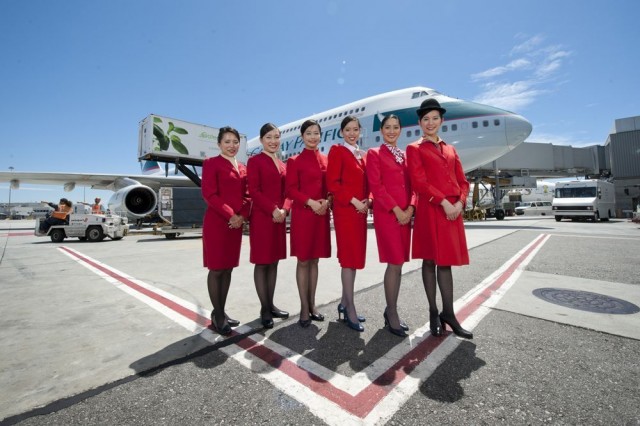
Cathay cabin crew lined up to bid farewell to their North American 747 operations – Photo: Cathay Pacific Airways
On August 13, 2014 Cathay Pacific Airways celebrated its last 747 flight of any sort to North America. This is an iconic moment, as Cathay Pacific has been flying the 747 to North America, starting with San Francisco, since 1986. That’s 28 years of daily 747s. Cathay itself has been in the commercial 747 business since August 3, 1979. The actual last 747 flight to San Francisco will take place on August 31.
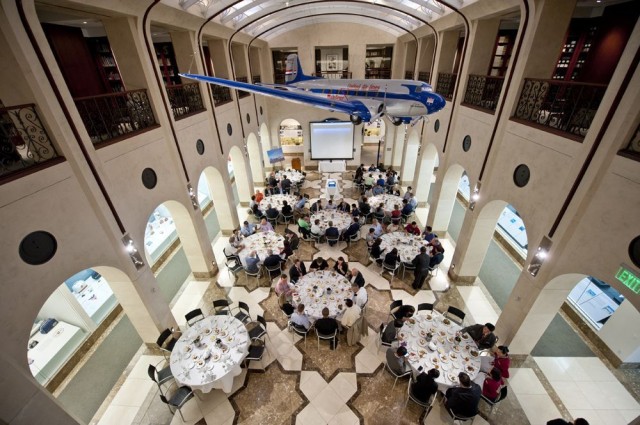
Cathay Pacific’s 747-400 farewell luncheon took place in San Francisco Airport’s museum – Photo: Cathay Pacific Airways
Cathay was not going to let this event pass without fanfare. At San Francisco Airport, they hosted a luncheon to celebrate the 747’s service in Cathay’s fleet.

How well do you know your airline liveries?
It is that time again to show how awesome you are at guessing airline liveries. How this works is I give you 12 small parts of an airliner and you need to tell me: #1 what airline does it belong to and #2 what kind of airplane is it?
Some are a little easier and others will be a bit tough, but can you guess all 12? Put your guesses into the comments (don’t cheat and just look at others’ answers). In a few days I will post all the answers with links to the original photos.
Game on!
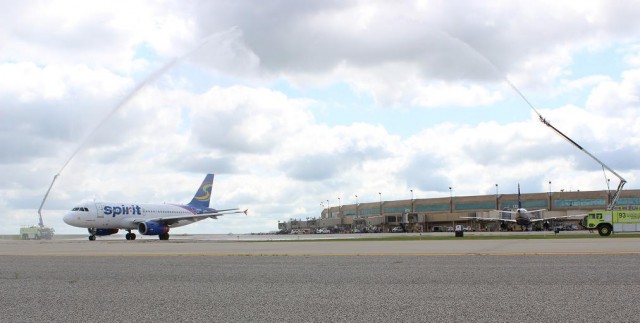
Spirit’s first flight out of Kansas City receives a dual water cannon salute – Photo: Aaron Wright, KC Aviation Dept.
It’s true, people vehemently despise Spirit Airlines. Just the mention of the company elicits emotion-filled horror stories. Indeed they have a solid 1 out of 5 star rating on TripAdvisor, and they are frequently found at, or near, the top of various “worst airline” rankings. In direct contrast to these ratings and frequent “I’ll never fly Spirit again” claims, the airline continues to grow and increase market share. This begs the question – is the experience really THAT bad? Or, is there something else at play here?
BONUS: The Five Stages of Flying an Ultra Low Cost Carrier (Epic Comic Style)
In their own defense, Spirit argues that the mass dissatisfaction with them is in large part due to consumers not understanding their progressive, totally unbundled Ultra Low Cost Carrier (ULCC) business model. That assertion seems to hold water. The vast majority of complaints I hear and see are indeed related to “unexpected fees” and being “nickel and dimed” to death. As the well-known cliche goes: “The first step to recovery is admitting you have a problem.” Thankfully, Spirit recognizes there is a problem. To that end they recently hired Barkley, a KC-based marketing firm to assist with better educating consumers and promoting what they refer to as a “bare fare.”
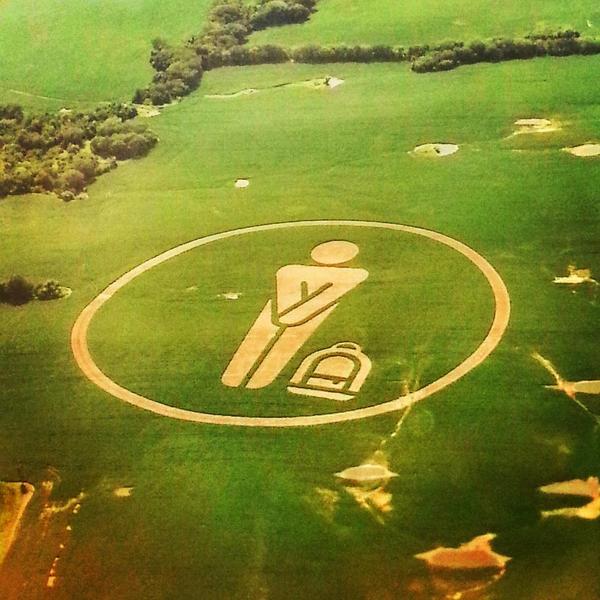
“Bare Fare” crop circle spotted in a soy field just north of the KC airport – Photo: Victor Lazo
A few months ago, Kansas City International airport announced that ours would be a new market served by Spirit. Shortly after an unexplained crop circle appeared prompting a lot of curiosity. It turned out the image seen above is the logo for Spirit’s Bare Fare.
I was excited to finally have the opportunity to give them a shot, contrary to the advice of everyone who I’d informed of my intentions. I booked a seat on the first flight out, and this is my honest, unbiased review…





